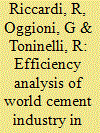|
|
|
Sort Order |
|
|
|
Items / Page
|
|
|
|
|
|
|
| Srl | Item |
| 1 |
ID:
112286


|
|
|
|
|
| Publication |
2012.
|
| Summary/Abstract |
While limited by its scarcity of natural resources, the impacts of energy price changes on Taiwan's economic activities have been an important issue for social public and government authorities. This study applies the multivariate threshold model to investigate the effects of various international energy price shocks on Taiwan's macroeconomic activity. By separating energy price changes into the so-called decrease and increase regimes, we can realize different impacts of energy price changes and their shocks on economic output. The results confirm that there is an asymmetric threshold effect for the energy-output nexus. The optimal threshold levels are exactly where the oil price change is at 2.48%, the natural gas price change is at 0.66%, and the coal price change is at 0.25%. The impulse response analysis suggests that oil price and natural gas shocks have a delayed negative impact on macroeconomic activities.
|
|
|
|
|
|
|
|
|
|
|
|
|
|
|
|
| 2 |
ID:
112294


|
|
|
|
|
| Publication |
2012.
|
| Summary/Abstract |
This paper investigates the role of comparative advantage on biofuel policy adoption. Results show that different countries have different drivers to create biofuel policies. GDP proves to be more significant for OECD countries, while arable land and feedstock prices are more significant for non-OECD countries. Land allocation may also be of importance. We speculate that a naturally endowed comparative advantage may not necessarily equate to a successful biofuel industry.
|
|
|
|
|
|
|
|
|
|
|
|
|
|
|
|
| 3 |
ID:
112296


|
|
|
|
|
| Publication |
2012.
|
| Summary/Abstract |
The Kyrgyz energy sector is characterised by a dramatic energy crisis that has deprived a substantial part of the population from access to energy. Non-traditional renewable energy sources have emerged as a promising alternative in providing basic energy services to the rural poor. Based on qualitative interview data from local households and project planners, this study sets out to assess impacts, limitations and barriers of non-traditional renewable energy projects in rural areas in Kyrgyzstan. This study argues that recent renewable energy efforts from multilateral international agencies, the private sector, and nongovernmental organisations exhibit great potential in creating tangible benefits and improving basic energy services, but have so far been inefficient in establishing and replicating sustainable and long-term energy solutions. Existing practices need to be improved by attaching greater importance to the capacities and real needs of the rural poor. The guidance of integrated programmes and policies along with alternative financing schemes and awareness-raising are urgently needed to leverage local success stories and to facilitate a sustainable energy development in rural Kyrgyzstan.
|
|
|
|
|
|
|
|
|
|
|
|
|
|
|
|
| 4 |
ID:
112302


|
|
|
|
|
| Publication |
2012.
|
| Summary/Abstract |
The prospect of a European Supergrid calls for research on aggregate electricity peak demand and Europe-wide Demand Side Management. No attempt has been made as yet to represent a time-related demand curve of residential electricity consumption at the European level. This article assesses how active occupancy levels of single-person households vary in single-person household in 15 European countries. It makes use of occupancy time-series data from the Harmonised European Time Use Survey database to build European occupancy curves; identify peak occupancy periods; construct time-related electricity demand curves for TV and video watching activities and assess occupancy variances of single-person households.
|
|
|
|
|
|
|
|
|
|
|
|
|
|
|
|
| 5 |
ID:
112297


|
|
|
|
|
| Publication |
2012.
|
| Summary/Abstract |
CO2 emissions reduction and energy efficiency improvement are the targets of many environmental policies that aim at tackling climate change. The European Emission Trading is the best example of this engagement against climate change. Considering this framework, this paper studies the efficiency of the high energetic and CO2 emissions intensive cement production process in 21 world countries. Alternative formulations of standard data envelopment analysis models and a directional distance function approach are compared in order to detect the efficiency of the cement sector both in presence and in absence of carbon emissions. We first analyze the entire cement production process and we then concentrate on the production of clinker, a by-product of cement, that is the main responsible of CO2 emissions. Our results show that the inclusion or the exclusion of undesirable factors (CO2) influence efficiency levels as well as the investments in new technologies and the utilization of alternative fuels and raw materials in the cement and clinker production processes.
|
|
|
|
|
|
|
|
|
|
|
|
|
|
|
|
| 6 |
ID:
112307


|
|
|
|
|
| Publication |
2012.
|
| Summary/Abstract |
The causal relationships between energy consumption and economic growth have given rise to much discussion but remain controversial. Alternative data sets based on different time spans, countries, energy policies and econometric approaches result in diverse outcomes. A meta analysis using a multinomial logit model with 174 samples governing the relationships between GDP and energy consumption is applied here to investigate the major factors that affect these controversial outcomes. The empirical results have demonstrated how the time spans, subject selections including GDP and energy consumption, econometric models, and tools for greenhouse gases emission reduction characteristics significantly affect these controversial outcomes.
|
|
|
|
|
|
|
|
|
|
|
|
|
|
|
|
| 7 |
ID:
112298


|
|
|
|
|
| Publication |
2012.
|
| Summary/Abstract |
The processing costs of US corn ethanol have declined by 45% since 1983 as production volumes have increased seventeen-fold. We investigate the role of various factors that could explain this, including economies of scale, cumulative experience, induced innovation in response to rising input prices, an autonomous technological change, and trade induced competition from imported ethanol. Using data on dry-mill ethanol processing costs over the 1983-2005 period, we find evidence to show that US corn ethanol production exhibited decreasing returns to scale, that learning by doing played an important role in reducing these processing costs with a learning rate of 0.25, and that sugarcane ethanol imports contributed to making the corn ethanol industry more competitive. Other factors such as the rising prices of energy and labor did induce lower processing costs, but the effect is not statistically significant. The inclusion of these competing explanations for the reduction in processing costs of US corn ethanol lead to a significantly higher learning rate than otherwise, and this learning rate is found to be robust across specifications.
|
|
|
|
|
|
|
|
|
|
|
|
|
|
|
|
| 8 |
ID:
112303


|
|
|
|
|
| Publication |
2012.
|
| Summary/Abstract |
Designing measures for the reduction of energy consumption in urban areas is a complex venture indeed. In terms of urban sustainability, such measures affect energy efficiency as well as environmental, economic and social aspects. Numerous publications dealt with such methodological approaches in the past, whilst the subject of sustainable urban areas and cities is constantly gaining interest. Furthermore, energy performance depends on building density, occupancy and consumer profile, climatic conditions, not least construction quality, factors linked, directly or not, to socioeconomic aspects. Greek cities are known for their density, their polymorphic structure and their complexity. Thus, planning energy conservation measures is a difficult task, demanding a precise methodological approach, which will embody most of these aspects to a great extent. This paper proposes a methodology on how to manage Greek cities in terms of their energy efficiency, emphasizing on the residential stock.
|
|
|
|
|
|
|
|
|
|
|
|
|
|
|
|
| 9 |
ID:
112285


|
|
|
|
|
| Publication |
2012.
|
| Summary/Abstract |
With rapidly increasing energy consumption attributed to residential buildings in South Korea, there is a need to update requirements of the building energy code in order to improve the energy performance of buildings. This paper provides some guidelines to improve the building energy code to better select glazing types that minimize total energy use of residential buildings in Korea. In particular, detailed energy simulation analyses coupled with economical and environmental assessments are carried out to assess the thermal, economical, and environmental impacts of glazing thermal characteristics as well as window sizes associated with housing units in various representative climates within South Korea. The results of the analyses have clearly indicated that selecting glazing with low solar heat gain coefficient is highly beneficial especially for large windows and for mild climates. In particular, it is found that using any double-pane low-e glazing would provide better performance for windows in residential buildings than the clear double-pane glazing, currently required by the Korean building energy code.
|
|
|
|
|
|
|
|
|
|
|
|
|
|
|
|
| 10 |
ID:
112295


|
|
|
|
|
| Publication |
2012.
|
| Summary/Abstract |
Industrial energy efficiency is of paramount importance both for conserving energy resources and reducing CO2 emissions. In this paper, we compare specific energy consumption among countries in fossil power generation, steel, and cement sectors. The evaluations were conducted using common system boundaries, allocation, and calculation methods. In addition, we disaggregate within sectors, such as with blast furnace-basic oxygen furnace (BF-BOF) steel and scrap-based electric arc furnace (Scrap-EAF) steel. The results reveal that characteristics vary by sub-sector. Regional differences in specific energy consumption are relatively large in the power, BF-BOF steel, and cement sectors. For coal power generation and BF-BOF steel production, continual maintenance and rehabilitation are of key importance. We confirm these key factors identified in the previous work on our estimated numerical values. In BF-BOF steel production, corrections for hot metal ratios (pig iron production per unit of BOF crude steel production) and quality of raw materials have a large effect on the apparent specific energy consumption. Available data is not yet sufficient for straightforward evaluation of the steel and cement sectors.
|
|
|
|
|
|
|
|
|
|
|
|
|
|
|
|
| 11 |
ID:
112311


|
|
|
|
|
| Publication |
2012.
|
| Summary/Abstract |
This paper presents a first assessment of the renewable energy projects, proposed by the nine Mediterranean Partner Countries (MPCs) under the Mediterranean Solar Plan (MSP) and the associated potential economic impacts. As one of the priority projects of the Union for the Mediterranean (UfM), the MSP's objective which attracted most attention until now is the intention to deploy an additional 20 GW of renewable electrical capacity in the Southern and Eastern Mediterranean region (covering the MPCs plus Turkey) by 2020. The main findings of this research are: (1) as of February 2010, a total of 10.3 GW of renewable project proposals were identified in the MPCs, corresponding to about half of the 20 GW target; (2) investment needs for the identified projects could amount to EUR 21 billion by 2020, which represents about five times the amount invested by the region in conventional electricity generation in the last decade; and (3) the difference between the cost of renewable electricity generation and the economic cost of its fossil fuel alternatives could amount to EUR 1.2 billion. Insights stemming from the results of this research can generate useful regional messages for energy policy leaders in the MPCs to accelerate the development of renewable energy projects.
|
|
|
|
|
|
|
|
|
|
|
|
|
|
|
|
| 12 |
ID:
112290


|
|
|
|
|
| Publication |
2012.
|
| Summary/Abstract |
California's target for reducing economy-wide greenhouse gas (GHG) emissions is 80% below 1990 levels by 2050. We develop transition scenarios for meeting this goal in California's transportation sector, with focus on light-duty vehicles (LDVs). We explore four questions: (1) what options are available to reduce transportation sector GHG emissions 80% below 1990 levels by 2050; (2) how rapidly would transitions in LDV markets, fuels, and travel behaviors need to occur over the next 40 years; (3) how do intermediate policy goals relate to different transition pathways; (4) how would rates of technological change and market adoption between 2010 and 2050 impact cumulative GHG emissions?
We develop four LDV transition scenarios to meet the 80in50 target through a combination of travel demand reduction, fuel economy improvements, and low-carbon fuel supply, subject to restrictions on trajectories of technological change, potential market adoption of new vehicles and fuels, and resource availability.
These scenarios exhibit several common themes: electrification of LDVs, rapid improvements in vehicle efficiency, and future fuels with less than half the carbon intensity of current gasoline and diesel. Availability of low-carbon biofuels and the level of travel demand reduction are "swing factors" that influence the degree of LDV electrification required.
|
|
|
|
|
|
|
|
|
|
|
|
|
|
|
|
| 13 |
ID:
112299


|
|
|
|
|
| Publication |
2012.
|
| Summary/Abstract |
Electric vehicles have recently been gaining increasing worldwide interest as a promising potential long-term solution to sustainable personal mobility; in particular, battery electric vehicles (BEVs) offer zero tailpipe emissions. However, their true ability to contribute to greenhouse gas (GHG) emissions reductions can only be properly assessed by comparing a life cycle assessment of their GHG emissions with a similar assessment for conventional internal combustion vehicles (ICVs).
This paper presents an analysis for vehicles typically expected to be introduced in 2015 in two example markets (the UK and California), taking into account the impact of three important factors:
•
Like-for-like vehicle comparison and effect of real-world driving conditions.
•
Accounting for the GHG emissions associated with meeting the additional electricity demand for charging the batteries.
•
GHG emissions associated with vehicle manufacture, disposal, etc.
This work demonstrates that all of these factors are important and emphasises that it is therefore crucial to clearly define the context when presenting conclusions about the relative GHG performance of BEVs and ICVs - such relative performance depends on a wide range of factors, including the marginal regional grid GHG intensity, vehicle size, driving pattern, loading, etc.
|
|
|
|
|
|
|
|
|
|
|
|
|
|
|
|
| 14 |
ID:
112291


|
|
|
|
|
| Publication |
2012.
|
| Summary/Abstract |
Economists have studied various indicators of resource scarcity but largely ignored the phenomenon of "peaking" due to its connection to non-economic (physical) theories of resource exhaustion. I consider peaking from the economic point of view, where economic forces determine the shape of the equilibrium extraction path. Within that framework, I ask whether the timing of peak production reveals anything useful about scarcity. I find peaking to be an ambiguous indicator. If someone announced the peak would arrive earlier than expected, and you believed them, you would not know whether the news was good or bad. However, I also show that the traditional economic indicators of resource scarcity (price, cost, and rent) fare no better, and argue that previous studies have misconstrued the connection between changes in underlying scarcity and movements in these traditional indicators.
|
|
|
|
|
|
|
|
|
|
|
|
|
|
|
|
| 15 |
ID:
112301


|
|
|
|
|
| Publication |
2012.
|
| Summary/Abstract |
This paper explores the issues related to regulatory reform and liberalisation leading toward competition in the Thai electricity sector, which is still under the monopoly control of state-owned enterprises (SOEs). Following an overview of the current market structure of the Thai electricity sector, the process of liberalisation and deregulation that contributes to the uncompetitive market structure under SOEs' control is examined. The author asserts that there are problems within the Energy Commission and the Energy Industry Act BE 2550 (2007) that contribute to the continuance of an uncompetitive electricity supply. Possible reforms to the Thai electricity regulation are proposed with the aim of creating market competition and efficiency in the Thai electricity sector.
|
|
|
|
|
|
|
|
|
|
|
|
|
|
|
|
| 16 |
ID:
112300


|
|
|
|
|
| Publication |
2012.
|
| Summary/Abstract |
United States energy policymaking can be better supported with accurate and consistent data on coal reserves, both in the public and private sectors. In particular, reserve data for coal and other energy resources should be directly comparable so that decision-makers can easily understand the relationship among available resources. Long-term policy and investment choices regarding energy security, the environment, and resource allocation depend on accurate information, but existing and easily available data on the magnitude of geologically, environmentally, economically, socially, and legally accessible coal reserves are of insufficient quality to guide such decisions. Even still, these data are often presented for use in policy and energy analysis. Currently, coal reserves are overstated relative to competitor energy resource reserves, in part because coal reporting standards have historically been more liberal and vague than standards for resources like natural gas. Overstating the marketable coal resource could lead to inefficient allocation of limited capital investment that can be difficult to reverse. US government bodies like the Energy Information Administration, United States Geological Survey, Securities and Exchange Commission, and Bureau of Land Management can help correct deficiencies by clarifying standards and collecting data that are relevant for decision-makers, such as energy-based reserve information.
|
|
|
|
|
|
|
|
|
|
|
|
|
|
|
|
|
|
|
|
|